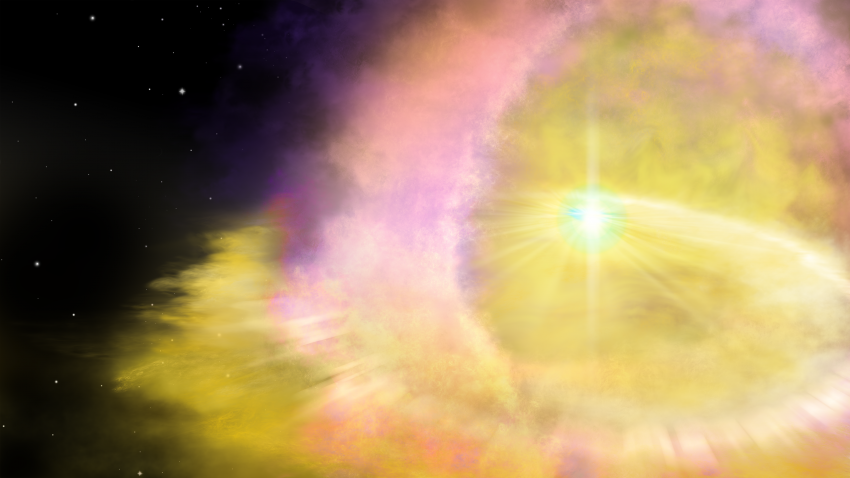A supernova at least twice as bright and energetic, and likely much more massive than any yet recorded has been identified by an international team of astronomers, led by RAS Research Fellowship holder Dr Matt Nicholl at the University of Birmingham.
The team, which included experts from Harvard, Northwestern University and Ohio University, believe the supernova, dubbed SN2016aps, could be an example of an extremely rare ‘pulsational pair-instability’ supernova, possibly formed from two massive stars that merged before the explosion. Their findings are published today in Nature Astronomy.
Such an event so far only exists in theory and has never been confirmed through astronomical observations.
Dr Nicholl, of the School of Physics and Astronomy and the Institute of Gravitational Wave Astronomy at the University of Birmingham, explains: “We can measure supernovae using two scales – the total energy of the explosion, and the amount of that energy that is emitted as observable light, or radiation.”
“In a typical supernova, the radiation is less than 1 per cent of the total energy. But in SN2016aps, we found the radiation was five times the explosion energy of a normal-sized supernova. This is the most light we have ever seen emitted by a supernova.”
In order to become this bright, the explosion must have been much more energetic than usual. By examining the light spectrum, the team were able to show that the explosion was powered by a collision between the supernova and a massive shell of gas, shed by the star in the years before it exploded.
"While many supernovae are discovered every night, most are in massive galaxies,” said Dr Peter Blanchard, from Northwestern University and a co-author on the study. “This one immediately stood out for further observations because it seemed to be in the middle of nowhere. We weren’t able to see the galaxy where this star was born until after the supernova light had faded.”
The team observed the explosion for two years, until it faded to 1 per cent of its peak brightness. Using these measurements, they calculated the mass of the supernova was between 50 to 100 times greater than our Sun (solar masses). Typically supernovae have masses of between 8 and 15 solar masses.
“Stars with extremely large mass undergo violent pulsations before they die, shaking off a giant gas shell. This can be powered by a process called the pair instability, which has been a topic of speculation for physicists for the last 50 years,” says Dr Nicholl. “If the supernova gets the timing right, it can catch up to this shell and release a huge amount of energy in the collision. We think this is one of the most compelling candidates for this process yet observed, and probably the most massive.”
“SN2016aps also contained another puzzle,” added Dr Nicholl. “The gas we detected was mostly hydrogen – but such a massive star would usually have lost all of its hydrogen via stellar winds long before it started pulsating. One explanation is that two slightly less massive stars of around, say 60 solar masses, had merged before the explosion. The lower mass stars hold onto their hydrogen for longer, while their combined mass is high enough to trigger the pair instability.”
“Finding this extraordinary supernova couldn’t have come at a better time,” according to Professor Edo Berger, a co-author from Harvard University. “Now that we know such energetic explosions occur in nature, NASA’s new James Webb Space Telescope will be able to see similar events so far away that we can look back in time to the deaths of the very first stars in the Universe.”
Supernova 2016aps was first detected in data from the Panoramic Survey Telescope and Rapid Response System (Pan-STARRS), a large-scale astronomical survey programme. The team also used data from the Hubble Space Telescope, the Keck and Gemini Observatories, in Hawaii, and the MDM and MMT Observatories in Arizona. Other collaborating institutions included Stockholm University, Copenhagen University, California Institute of Technology, and Space Telescope Science Institute.
The research was funded through a Royal Astronomical Society Research Fellowship, along with grants from the National Science Foundation, NASA and the Horizon 2020 European Union Framework Programme.
Media contact
Beck Lockwood
Press Office, University of Birmingham
Tel: +44 (0)121 414 2772
Out of hours mobile: +44 (0)7789 921165
r.lockwood@bham.ac.uk / pressoffice@contacts.bham.ac.uk
Science contact
Dr Matt Nicholl
University of Birmingham
mnicholl@star.sr.bham.ac.uk
Further information
The new work appears in "An extremely energetic supernova from a very massive star in a dense medium", Nicholl M. et al., Nature Astronomy (2020) (DOI: 10.1038/s41550-020-1066-7).
Notes for editors
The University of Birmingham is ranked amongst the world’s top 100 institutions. Its work brings people from across the world to Birmingham, including researchers, teachers and more than 6,500 international students from over 150 countries.
Follow the University on Twitter
The Royal Astronomical Society (RAS), founded in 1820, encourages and promotes the study of astronomy, solar-system science, geophysics and closely related branches of science. The RAS organises scientific meetings, publishes international research and review journals, recognises outstanding achievements by the award of medals and prizes, maintains an extensive library, supports education through grants and outreach activities and represents UK astronomy nationally and internationally. Its more than 4,400 members (Fellows), a third based overseas, include scientific researchers in universities, observatories and laboratories as well as historians of astronomy and others.
The RAS accepts papers for its journals based on the principle of peer review, in which fellow experts on the editorial boards accept the paper as worth considering. The Society issues press releases based on a similar principle, but the organisations and scientists concerned have overall responsibility for their content.
In 2020 the RAS is 200 years old. The Society is celebrating its bicentennial anniversary with a series of events around the UK, including public lectures, exhibitions, an organ recital, a pop-up planetarium, and the culmination of the RAS 200: Sky & Earth project.
Follow the RAS on Twitter, Facebook, Instagram and YouTube
Download the RAS Podcast from Audioboom


